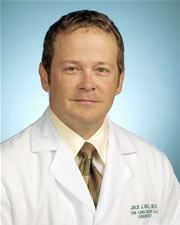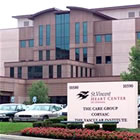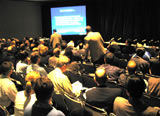 |

|
 |

Cardiologist
Jack J. Hall, MD, FACC, is Program Director of the Care Group
at
St.
Vincent's Heart Center in Indianapolis, Indiana
-- a practice that traces its roots back to the beginnings
of interventional
cardiology in the U.S. and specifically Indiana, and to such
early innovators as Cass Pinkerton and Thomas Linnemeier.
Dr.
Hall himself has been a pioneer in the use of the transradial
approach, having practiced it for over 15 years. Recognizing
the need for training in this rapidly-spreading technique,
Dr. Hall is one of the organizers of the Indianapolis
Transradial Summit, being held on April 30, 2011, which will
be focusing on will focus on presenting practical, straightforward
information important in establishing or expanding a transradial
practice. In this interview, Dr. Hall discusses the evolution
of the transradial technique and its future implications
for patient care and economic benefit in the U.S.
A
complete list of educational offerings for the transradial
approach
can be found on the Transradial
Training Courses page in Angioplasty.Org's Radial
Access Center. |
|

Jack J.
Hall, MD, FACC |
Q: Tell me about the upcoming Indianapolis Transradial Summit.
Dr. Hall: We're looking forward to advancing transradial technique
out to more U.S. physicians, particularly here in the central Indiana
region and the Midwest. We hope to bring in not only physicians
and hospitals that want to start transradial programs, but also
people that have adopted the technique recently and want to refine
their technique with new tips and tricks. As a small deviation
from our usual transradial training, we also want to offer transradial
training to hospitals, hospital administrators, cath lab managers
and CV service line administrators, such that they can learn along
with their physicians about the transradial technique and what
it may mean to their facility from an economic standpoint, patient
throughput standpoint and, of course, help everyone to understand
the clinical advantage of the transradial, and how patients certainly
prefer it compared to the transfemoral approach.
| "We've known
for a long time...that vascular access complications result
in not only morbidity and potential mortality for our patients,
but a huge expense
to our facilities and to our healthcare system as a whole.
So any procedures that we can do that will limit our access
site complication rate will not only be good for our patients
clinically, but help our healthcare system..." |
|
Q: Your course
is coming closely on the public conversations about Medicare
cost-savings. What are the economic implications of moving
to transradial: how can it affect the bottom line, both from
reduced complications and increased efficiency?
Dr. Hall: The
easy one is from complications. We've known for a long time,
and anybody in the cardiovascular field understands, that vascular
access complications result in not only morbidity and potential
mortality for our patients, but a huge expense to our facilities
and to our healthcare system as a whole. So any procedures
that we can do that will limit our access site complication
rate will not only be good for our patients clinically, but
help our healthcare system which, I think we all agree, needs
more help.
The other side of the equation is how does transradial help
facilities from an economic standpoint? And the first big hump,
as we discussed, was the decrease in morbidity and mortality
from the complications of the vascular access. But we also
have demonstrated, and many others have demonstrated, a lower
cost of care because we're getting the patients up and mobilizing
them so much faster so that they can be discharged from the
facility much sooner than our previous attempts in the U.S.
from the transfemoral approach. The use of [transfemoral]
closure devices has not helped us from an economic standpoint. There
are still many studies that demonstrate that closure devices don’t
decrease the vascular access complication rates as low as we would
like, and there are certainly added costs involved with vascular
closure devices. |
So if we can bring a patient in and do a transradial
approach, have lower complication rates and be able to discharge
that patient within a few hours of the procedure, that improves the
throughput for the facility, decreases costs across the board. We
also have demonstrated in our facility a decreased pharmacy cost
in these patients. Not only are they not in the hospital as long,
therefore they aren’t getting as many medications through our
pharmacy, but also with the femoral approach we do manual compression
often, and those patients receive more medications for anxiety and
for discomfort, getting the sheath out and then they also frequently
receive more pain medications while they're on bed rest, because
most of our patients do have some discomfort from lying on their
back for hours after the procedure.
Q: Angioplasty.Org’s patient
Forums get patients writing in that they wind up with significant
back problems from
lying
flat
so long.
Dr. Hall: Absolutely. Anyone who's ever had any procedure, the bed
rest is miserable. I've had knee surgery and understand some of those
issues personally.

St. Vincent's
Heart Center,
Indianapolis |
|
Q: How long have you and St.
Vincent's been offering the radial approach? How did it start
and what challenges needed to be overcome?
Dr. Hall: I started doing transradial procedures in the mid-90s,
around 1994. We brought it back and did our first 20 or so patients
in a series and actually got that published in the American Journal
of Cardiology in 1996. From then on we were convinced that patients
really preferred the transradial approach.
We had some limitations
during the mid-90s with equipment from a percutaneous revascularization
standpoint, but certainly there were many patients that benefitted
from our transradial approach due to body habitus issues or peripheral
vascular disease. |
One of the biggest categories is the patients who
are anticoagulated with Coumadin or other anticoagulants who needed
urgent or emergent procedures. With the low bleeding complication
rates from a transradial approach, we felt very comfortable even
early on in doing those patients from a transradial approach and
have continued to utilize the technique in those patients. But as
the equipment has improved, we've expanded our transradial approach
to multiple interventions and complex interventions, as well as acute
STEMI care.
Q: That was one of the interesting results from the RIVAL
Trial presented this month at the ACC. There was a definite advantage for
transradial in STEMI cases.
Dr. Hall: Certainly. I think that when you look back over the angioplasty
history, and you know this better than most, Burt, our issues have
always been that we know more anticoagulation, more blood thinners,
more antiplatelet agents are better from an ischemic standpoint for
our patients, but we also know that more blood thinners, more antiplatelet
agents, etc. also increase our patients' risk for bleeding complications.
Here now we have a technique that will limit the bleeding complications
which should allow us to have more confidence to proceed on with
more potent anticoagulants and get better ischemic outcomes.
Q: Dr. Mehta in Miami in
his interview said the same thing: that
perhaps the newest anticoagulant medications, bivalirudin in particular,
with the transradial approach might be the way to move forward with
STEMI patients.
Dr. Hall: Absolutely it's the way to go forward with STEMI patients.
And on the other side of the coin I think Samir Pancholy recently
demonstrated a case report of a patient who was at high risk for
bleeding complications, so he used the transradial approach to decrease
the vascular bleeding complications and then utilized bivalirudin
to decrease the non-vascular access site bleeding complications.
So it's kind of a two-pronged approach, depending on what patient
population you're seeing at that time. It has a lot of advantages.
Q: Cardiologists in Europe and
around the world look at articles published in the U.S. about
transradial and they
scratch
their heads
and say, "What's the big deal?" because they've been doing
this for a long time. Now you've also been doing this since the very
beginning of the wrist approach, so from your perspective, are things
in the U.S. really beginning to change?
Dr. Hall: I think it's been a dramatic change since I started doing
transradials. Early on in the U.S., doing a transradial procedure
was almost heresy. Many of my colleagues would scoff at us; others
would say what we were doing was malpractice, such that when we went
to meetings and open forums, many of us did not even admit to doing
transradials. There were very few of us early on: Matt Mick, Tift
Mann, Dan McCormick. And it was great bumping into them at meetings
and sharing stories about transradial, and learning from each other.
But our ability to contact each other at that time was fairly limited.
We certainly didn't have
all the technology that we have now for sharing cases and discussing
with colleagues. So I found it really very rewarding
over the last five years to be able to go to conferences and
get information from other operators.
It used to be that I would
see a transradial article, always from Europe or Canada, Gerald
Barbeau et al, and read that with great vim and vigor, but
then not have another transradial article come out in print
for months.
Now it's hard to pick up a journal without seeing something
about transradial, and it's really adding to the body of the
science
and the information which will make us all better transradial
operators. |
|

National
Transradial Meeting |
It's nice to see it's catching on because,
as you pointed out, the United States is sorely behind in this technique,
as compared to the rest of the world. Depending on whom you read,
the U.S. penetration of 5% is woefully behind our European and Pacific
Rim counterparts and I certainly don’t feel that they value
their patient satisfaction and patient comfort more than us. I think
we're just slower to adopt the technique and hopefully, with everyone's
help, we're starting to make a dent in that and it's picking up momentum.
It's very rewarding to see.
Q: One of the things that’s
made it more popular is advances in the equipment, like needles
and introducer sheaths
and things
like that. Things have gotten smaller. Does it need to get better?
Dr. Hall: Everything in cardiology needs to get better, but certainly
industry and clinicians are driving to do that and we will continue
to see improvements. In our initial transradial experience, the equipment
we had was basically designed for the femoral approach and we had
more spasm then, we had more complex cases, cases took longer. And
then once we were able to get in, our ability to intervene in these
patients was limited due to our guiding catheter size and the balloon
and wire technologies. Now it is very easy both femorally and transradially
to do interventions, to go through a 6F or a 5F guide, even complex
procedures through these smaller guides is now more the mainstay.
So as industry has continued to supply us with improved product we’ve
been able to translate that into better clinical utility.
Q: It’s been said that
the increased use of transradial and the motivation for cardiologists
to learn the technique is
going
to be patient-driven, as people start to learn that they can get
these procedures done with less pain, less morbidity, quicker recovery.
Dr. Hall: Early on in our experience we've known that patients really
appreciated the transradial approach vs. the transfemoral approach.
It was more comfortable for them, especially the early ambulation.
They really preferred the transradial approach and once they had
it done, they would request it. And the way we would build some of
the practice was word-of-mouth. They would go to church or the grocery
store or within their own family, such that people would be referred
in because they knew we could do it transradially. Nowadays with
the vast amount of information and access to the internet and sites
such as Angioplasty.Org, patients can get volumes of information
virtually with a few clicks of the mouse. So we're excited to see
the American public becoming a better educated consumer of healthcare
and will hopefully help drive the transradial technique as well.
Q: Where do you see things going in the immediate future?
Dr. Hall: I think that it is important in the United States with
the changes in healthcare that we need, as physicians and clinicians,
to partner with the hospitals and hospital administration, bringing
in new technologies, new techniques, what have you. It really needs
to be a joint venture. It is no longer just the patient and the
doctor demanding this. We have to make sure we're doing the right
thing short and long term from both a clinical standpoint but also
a financial standpoint. I think that we're all feeling that pressure.
Perhaps we're a little late and behind the curve in feeling that
pressure compared to the rest of the world. But that's one of the
focuses of the Transradial Summit that we're putting on in Indianapolis:
to help hospital administrators understand this new technique,
so that when a young physician comes back and says, "I want
to do transradial," we hopefully will lower the barriers to
adoption. The hospital administrator will say, "Yes. I've
heard about that and understand the advantages to the patient and
the advantages to my facilities. Let's work on this together and
develop a multidisciplinary team approach, involving hospital staff,
the clinicians, the patients as well as hospital administration.”
Along those lines I would also like to point
out that, as you know, there are many industrial companies out
there with transradial products.
But quite frankly, the profit margins on these small products are
fairly small. We aren't talking about drug-eluting stents or new
hip prostheses, or percutaneous aortic valves – these transradial
items are fairly low profit things, yet industry has been very supportive
of transradial. They are very excited at assisting us from an educational
standpoint and getting the word out, and supporting our educational
symposia, even though it might not translate into selling more products
for them. And I think that we often malign industry and give them
a bad rap. I think that this is a case where industry is going above
and beyond in helping with educational support and they need a pat
on the back because I think they deserve it.
This interview was conducted in April
2011 by Burt Cohen of Angioplasty.Org. |




